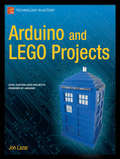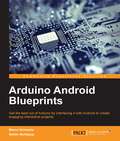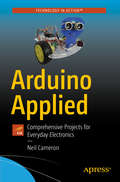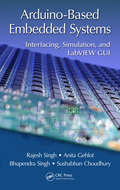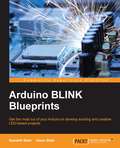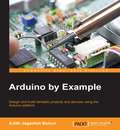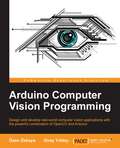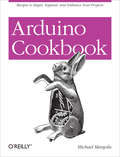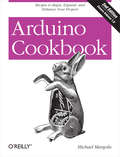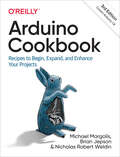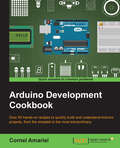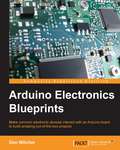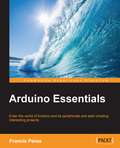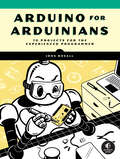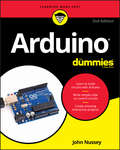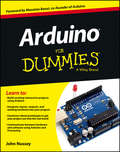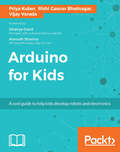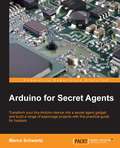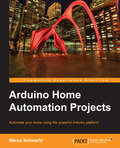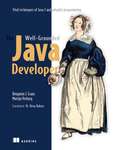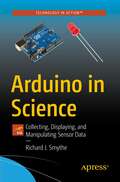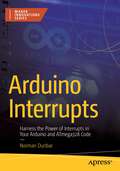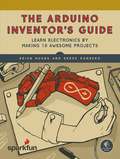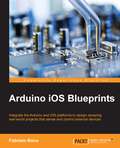- Table View
- List View
Arduino and LEGO Projects
by Jon LazarWe all know how awesome LEGO is, and more and more people are discovering how many amazing things you can do with Arduino. In Arduino and LEGO Projects, Jon Lazar shows you how to combine two of the coolest things on the planet to make fun gadgets like a Magic Lantern RF reader, a sensor-enabled LEGO music box, and even an Arduino-controlled LEGO train set. Learn that SNOT is actually cool (it means Studs Not on Top) See detailed explanations and images of how everything fits together Learn how Arduino fits into each project, including code and explanations Whether you want to impress your friends, annoy the cat, or just kick back and bask in the awesomeness of your creations, Arduino and LEGO Projects shows you just what you need and how to put it all together.
Arduino Android Blueprints
by Marco Schwartz Stefan ButtigiegThis book is for those who want to learn how to build exciting Arduino projects by interfacing it with Android. You will need to have some basic experience in electronics and programming. However, you don't need to have any previous experience with the Arduino or Android platforms.
Arduino Applied: Comprehensive Projects For Everyday Electronics
by Neil CameronExtend the range of your Arduino skills, incorporate the new developments in both hardware and software, and understand how the electronic applications function in everyday life. This project-based book extends the Arduino Uno starter kits and increases knowledge of microcontrollers in electronic applications. Learn how to build complex Arduino projects, break them down into smaller ones, and then enhance them, thereby broadening your understanding of each topic.You'll use the Arduino Uno in a range of applications such as a blinking LED, route mapping with a mobile GPS system, and uploading information to the internet. You'll also apply the Arduino Uno to sensors, collecting and displaying information, Bluetooth and wireless communications, digital image captures, route tracking with GPS, controlling motors, color and sound, building robots, and internet access. With Arduino Applied, prior knowledge of electronics is not required, as each topic is described and illustrated with examples using the Arduino Uno.
Arduino-Based Embedded Systems: Interfacing, Simulation, and LabVIEW GUI
by Rajesh Singh Anita Gehlot Bhupendra Singh Sushabhan ChoudhuryArduino is an open-source electronics platform based on easy-to-use hardware and software while LabVIEW is a graphical programming telling how to connect functions and work with a variety of datatypes when constructing applications.This book will help beginners to get started with Arduino-based embedded systems including essential know-how of the programming and interfacing of the devices. Book includes programming and simulation of Arduino-based projects and interfacing with LabVIEW, based on practical case studies. The book comprises of total twenty five chapters with description, working model of LabVIEW and programming with Arduino IDE.
Arduino BLINK Blueprints
by Utsav Shah Samarth ShahAnyone with a basic computer knowledge should be able to get the most out of this book. Although familiarity with some of the electronics would be helpful, it is not a must.
Arduino by Example
by Adith Jagadish BoloorDesign and build fantastic projects and devices using the Arduino platform About This Book * Explore the different sensors that can be used to improve the functionality of the Arduino projects * Program networking modules in conjunction with Arduino to make smarter and more communicable devices * A practical guide that shows you how to utilize Arduino to create practical, useful projects Who This Book Is For This book is an ideal choice for hobbyists or professionals who want to create quick and easy projects with Arduino. As a prerequisite, readers must have a working Arduino system and some programming background, ideally in C/C++. Basic knowledge of Arduino is helpful but not required to follow along with this book. What You Will Learn * Understand and utilize the capabilities of the Arduino * Integrate sensors to gather environmental data and display this information in meaningful ways * Add modules such as Bluetooth and Wi-fithat allow the Arduino to communicate and send data between devices * Create simple servers to allow communication to occur * Build automated projects including robots while learning complex algorithms to mimic biological locomotion * Implement error handling to make programs easier to debug and look more professional * Integrate powerful programming tools and software such as Python and Processing to broaden the scope of what the Arduino can achieve * Practice and learn basic programming etiquette In Detail Arduino an opensource physical computing platform based on a simple microcontroller board, and a development environment for writing software for the board. The opensource Arduino software (IDE) makes it easy to write code and upload it to the board. It runs on Windows, Mac OS X, and Linux. The environment is written in Java and based on Processing and other opensource software. With the growing interest in home-made, weekend projects among students and hobbyists alike, Arduino offers an innovative and feasible platform to create projects that promote creativity and technological tinkering. Arduino by Example is a project-oriented guide to help you fully utilize the power of one of the world's most powerful open source platforms, Arduino. This book demonstrates three projects ranging from a home automation project involving your lighting system to a simple robotic project to a touch sensor project. You will first learn the basic concepts such as how to get started with the Arduino, and as you start building the project, you will develop the practical skills needed to successfully build Arduino powered projects that have real-life implications. The complexity of the book slowly increases as you complete a project and move on to the next. By the end of this book, you will be able to create basic projects and utilize the elements used in the examples to construct your own devices. Style and approach This book follows a project-oriented approach, with multiple images and plenty of code to help you build your projects easily. The book uses a tutorial-based methodology where the concepts are first explained and then implemented to help you develop the projects.
Arduino Computer Vision Programming
by Özen Özkaya Giray YillikciIf you are a consumer and hobbyist who has familiarity with the basics of Arduino and wish to learn computer vision programming with Arduino to create intelligent systems, then this book is for you. No knowledge of computer vision programming is required.
Arduino Cookbook (Oreilly And Associate Ser.)
by Michael MargolisCreate your own toys, remote controllers, alarms, detectors, robots, and many other projects with the Arduino device. This simple microcontroller board lets artists and designers build a variety of amazing objects and prototypes that interact with the physical world. With this cookbook you can dive right in and experiment with more than a hundred tips and techniques, no matter what your skill level is.The recipes in this book provide solutions for most common problems and questions Arduino users have, including everything from programming fundamentals to working with sensors, motors, lights, and sound, or communicating over wired and wireless networks. You'll find the examples and advice you need to begin, expand, and enhance your projects right away.Get to know the Arduino development environmentUnderstand the core elements of the Arduino programming languageUse common output devices for light, motion, and soundInteract with almost any device that has a remote controlLearn techniques for handling time delays and time measurementUse simple ways to transfer digital information from sensors to the Arduino deviceCreate complex projects that incorporate shields and external modulesUse and modify existing Arduino libraries, and learn how to create your own
Arduino Cookbook: Recipes to Begin, Expand, and Enhance Your Projects (Oreilly And Associate Ser.)
by Michael MargolisWant to create devices that interact with the physical world? This cookbook is perfect for anyone who wants to experiment with the popular Arduino microcontroller and programming environment. You'll find more than 200 tips and techniques for building a variety of objects and prototypes such as toys, detectors, robots, and interactive clothing that can sense and respond to touch, sound, position, heat, and light. You don't need experience with Arduino or programming to get started. Updated for the Arduino 1.0 release, the recipes in this second edition include practical examples and guidance to help you begin, expand, and enhance your projects right away--whether you're an artist, designer, hobbyist, student, or engineer. Get up to speed on the Arduino board and essential software concepts quickly Learn basic techniques for reading digital and analog signals Use Arduino with a variety of popular input devices and sensors Drive visual displays, generate sound, and control several types of motors Interact with devices that use remote controls, including TVs and appliances Learn techniques for handling time delays and time measurement Apply advanced coding and memory handling techniques
Arduino Cookbook: Recipes to Begin, Expand, and Enhance Your Projects (Oreilly And Associate Ser.)
by Michael Margolis Brian Jepson Nicholas Robert WeldinWant to create devices that interact with the physical world? This cookbook is perfect for anyone who wants to experiment with the popular Arduino microcontroller and programming environment. You’ll find more than 200 tips and techniques for building a variety of objects and prototypes such as IoT solutions, environmental monitors, location and position-aware systems, and products that can respond to touch, sound, heat, and light.Updated for the Arduino 1.8 release, the recipes in this third edition include practical examples and guidance to help you begin, expand, and enhance your projects right away—whether you’re an engineer, designer, artist, student, or hobbyist.Get up to speed on the Arduino board and essential software concepts quicklyLearn basic techniques for reading digital and analog signalsUse Arduino with a variety of popular input devices and sensorsDrive visual displays, generate sound, and control several types of motorsConnect Arduino to wired and wireless networksLearn techniques for handling time delays and time measurementApply advanced coding and memory-handling techniques
Arduino Development Cookbook
by Cornel AmarieiIf you want to build programming and electronics projects that interact with the environment, this book will offer you dozens of recipes to guide you through all the major applications of the Arduino platform. It is intended for programming or electronics enthusiasts who want to combine the best of both worlds to build interactive projects.
Arduino Electronics Blueprints
by Don WilcherThis book is intended for those who want to learn about electronics and coding by building amazing devices and gadgets with Arduino. If you are an experienced developer who understands the basics of electronics, then you can quickly learn how to build smart devices using Arduino. The only experience needed is a desire to learn about electronics, circuit breadboarding, and coding.
Arduino Essentials
by Francis PereaIf you are a hobbyist who wants to develop projects based on Arduino as the main microcontroller platform or an engineer interested in finding out what the Arduino platform offers, then this book is ideal for you. Some prior knowledge of the C programming language is required.
Arduino for Arduinians: 70 Projects for the Experienced Programmer
by John BoxallGuided by an expert craftsman with over 30 years of experience, you&’ll build 70 awesome Arduino projects and emerge a true Arduinian ready to invent your own complex creations.For Arduino programmers who&’ve mastered the basics, this book is the next step toward becoming an expert Arduinian. You&’ll build 70 complex and practical projects with this versatile microcontroller platform and gain advanced skills to design reliable, professional, user-friendly creations.You&’ll remote-control your Arduino via Bluetooth and instant messaging, improve the accuracy of clock projects with internet time servers, and automatically turn your Arduino off when it completes a task. You&’ll safely control AC mains power and higher currents and conserve battery with low-power and sleep modes. You&’ll also use Charlieplexing to control LED matrix displays, keep your Arduino running with a watchdog timer, communicate over longer wired distances with the RS232 and RS485 buses, and much more.Along the way, you&’ll build fun and useful devices like:• A camera-enabled circuit to stream videos• An MP3 player to listen to audio of your choice• A CAN bus circuit to gather speed and engine data from your car• A web server to display data captured with an ESP32 board• A PS/2 keyboard to improve your user interfaces and easily enter and display dataGuided by an Arduino master, you&’ll harness dozens of sensors, motors, displays, and techniques to bring your own expert inventions to life.Requirements: Arduino Uno and other Arduino-compatible microcontrollers andUSBasp programmers. Some projects may require other inexpensive parts.
Arduino For Dummies
by John NusseyBring your ideas to life with the latest Arduino hardware and software Arduino is an affordable and readily available hardware development platform based around an open source, programmable circuit board. You can combine this programmable chip with a variety of sensors and actuators to sense your environment around you and control lights, motors, and sound. This flexible and easy-to-use combination of hardware and software can be used to create interactive robots, product prototypes and electronic artwork, whether you’re an artist, designer or tinkerer. Arduino For Dummies is a great place to start if you want to find out about Arduino and make the most of its incredible capabilities. It helps you become familiar with Arduino and what it involves, and offers inspiration for completing new and exciting projects. • Covers the latest software and hardware currently on the market • Includes updated examples and circuit board diagrams in addition to new resource chapters • Offers simple examples to teach fundamentals needed to move onto more advanced topics • Helps you grasp what’s possible with this fantastic little board Whether you’re a teacher, student, programmer, hobbyist, hacker, engineer, designer, or scientist, get ready to learn the latest this new technology has to offer!
Arduino For Dummies
by John NusseyThe quick, easy way to leap into the fascinating world of physical computingThis is no ordinary circuit board. Arduino allows anyone, whether you're an artist, designer, programmer or hobbyist, to learn about and play with electronics. Through this book you learn how to build a variety of circuits that can sense or control things in the real world. Maybe you'll prototype your own product or create a piece of interactive artwork? This book equips you with everything you'll need to build your own Arduino project, but what you make is up to you! If you're ready to bring your ideas into the real world or are curious about the possibilities, this book is for you.?? Learn by doing ? start building circuits and programming your Arduino with a few easy to follow examples - right away!? Easy does it ? work through Arduino sketches line by line in plain English, to learn of how a they work and how to write your own? Solder on! ? Only ever used a breadboard in the kitchen? Don't know your soldering iron from a curling iron? No problem, you'll be prototyping in no time? Kitted out ? discover new and interesting hardware to make your Arduino into anything from a mobile phone to a geiger counter!? Become an Arduino savant ? learn all about functions, arrays, libraries, shields and other tools of the trade to take your Arduino project to the next level.? Get social ? teach your Arduino to communicate with software running on a computer to link the physical world with the virtual worldIt's hardware, it's software, it's fun! Start building the next cool gizmo with Arduino and Arduino For Dummies.
Arduino for Kids
by Priya Kuber Rishi Gaurav Bhatnagar Vijay VaradaA cool guide to help kids develop robots and electronics About This Book • Get clearly-written code with descriptions and comments that explain each code section • The book comes with separate code files, one entire program at a time, as well as many diagrams and separate downloadable files that contain colored photos explaining steps in the book • Kids can build multiple projects during the course of the book; by the end, they will have working projects of their own Who This Book Is For This book is for children aged 9 and up, and their parents, who may or may not have a technical background. This book is tailored around the central idea of introducing electronics as a fun and a curiosity-inducing exercise. This book can act as a bonding exercise between parent and child over a single weekend. What You Will Learn • Write simple programs using variables, functions, loops, arrays, and libraries • Set up the Arduino and understand its internal functioning • Get to grips with connections in electronics and arrive at ways to connect various components yourself • Delve into various sensors and their selection and build your own sensor • Unravel the concept of resistors and capacitors along with understanding the physics of electronics • Become an inventor through interactive exercises (such as making a friend happy with a proximity sensor, and giving "life" to a plant) In Detail The mission of this book is to integrate technology with the tools that children already use for crafts so that they feel that the technology is an extension of their playtime. We use coding, sensors, and micro-controllers integrated with art and craft supplies, origami, and Playdough. There are 10 fun-filled chapters that talk to children directly, and give clear instructions for non-technical parents too. We use Arduino as the controller of choice due to its easy availability and large community. By the end of the book, children will comfortably be able to set up their Arduino, read and understand code, manipulate code, and ultimately write their own code for projects. They will also be able to use basic sensors and know how components connect to each other. All the learning takes place with lots of colorful pictures and the circuits are neatly presented using wiring. Style and approach This book will show you the glamour of common and easily available sensors, so that kids and parents waste no time searching for parts. We provide simple yet fun projects with step-by-step instructions that make it easy to get hands-on.
Arduino for Secret Agents
by Marco SchwartzTransform your tiny Arduino device into a secret agent gadget to build a range of espionage projects with this practical guide for hackers About This Book * Discover the limitless possibilities of the tiny Arduino and build your own secret agent projects * From a fingerprint sensor to a GPS Tracker and even a robot- learn how to get more from your Arduino * Build nine secret agent projects using the power and simplicity of the Arduino platform Who This Book Is For This book is for Arduino programmers with intermediate experience of developing projects, and who want to extend their knowledge by building projects for secret agents. It would also be great for other programmers who are interested in learning about electronics and programming on the Arduino platform. What You Will Learn * Get to know the full range of Arduino features so you can be creative through practical projects * Discover how to create a simple alarm system and a fingerprint sensor * Find out how to transform your Arduino into a GPS tracker * Use the Arduino to monitor top secret data * Build a complete spy robot! * Build a set of other spy projects such as Cloud Camera and Microphone System In Detail Q might have Bond's gadgets- but he doesn't have an Arduino (not yet at least). Find out how the tiny Arduino microcomputer can be used to build an impressive range of neat secret agent projects that can help you go undercover and get to grips with the cutting-edge of the world of espionage with this book, created for ardent Arduino fans and anyone new to the powerful device. Each chapter shows you how to construct a different secret agent gadget, helping you to unlock the full potential of your Arduino and make sure you have a solution for every tricky spying situation. You'll find out how to build everything from an alarm system to a fingerprint sensor, each project demonstrating a new feature of Arduino, so you can build your expertise as you complete each project. Learn how to open a lock with a text message, monitor top secret data remotely, and even create your own Arduino Spy Robot, Spy Microphone System, and Cloud Spy Camera This book isn't simply an instruction manual - it helps you put your knowledge into action so you can build every single project to completion. Style and approach This practical reference guide shows you how to build various projects with step-by-step explanations on each project, starting with the assembly of the hardware, followed by basics tests of all those hardware components and finally developing project on the hardware.
Arduino for the Cloud: Arduino Yun and Dragino Yun Shield
by Claus KuhnelArduino for the Cloud considers the Arduino Yun and the Dragino Yun Shield as components closing the gap between a typical microcontroller application and connection to the cloud. Arduino Yun combines the classic Arduino with an Atheros AR9331 system-on-a-chip (SoC) for wireless access points and routers platforms, which uses the Linux distribution Linino (OpenWRT) operating system. The Dragino Yun Shield expands any Arduino with network capabilities by the Atheros AR9331.The combination of microcontroller and Linux device supports the whole chain from sensor to software applications in the cloud by hardware and software. This book deals with the Arduino and the Linux device and their interaction, without the need of detailed Linux knowledge.
Arduino Home Automation Projects
by Marco SchwartzThis book is divided into projects that are explained in a step-by-step format, with practical instructions that are easy to follow. If you want to build your own home automation systems wirelessly using the Arduino platform, this is the book for you. You will need to have some basic experience in Arduino and general programming languages, such as C and C++ to understand the projects in this book.
Arduino in Action
by Jordan Hochenbaum Joshua Noble Martin EvansSummaryArduino in Action is a hands-on guide to prototyping and building electronics using the Arduino platform. Suitable for both beginners and advanced users, this easy-to-follow book begins with the basics and then systematically guides you through projects ranging from your first blinking LED through connecting Arduino to devices like game controllers or your iPhone.About the TechnologyArduino is an open source do-it-yourself electronics platform that supports a mind-boggling collection of sensors and actuators you can use to build anything you can imagine. Even if you've never attempted a hardware project, this easy-to-follow book will guide you from your first blinking LED through connecting Arduino to your iPhone.About this BookArduino in Action is a hands-on guide to prototyping and building DIY electronics. You'll start with the basics—unpacking your board and using a simple program to make something happen. Then, you'l attempt progressively more complex projects as you connect Arduino to motors, LCD displays, Wi-Fi, GPS, and Bluetooth. You'll explore input/output sensors, including ultrasound, infrared, and light, and then use them for tasks like robotic obstacle avoidance.Arduino programs look a lot like C or C++, so some programming skill is helpful.What's InsideGetting started with Arduino—no experience required!Writing programs for ArduinoSensing and responding to eventsRobots, flying vehicles, Twitter machines, LCD displays, and more!Purchase of the print book includes a free eBook in PDF, Kindle, and ePub formats from Manning Publications.About the AuthorsMartin Evans is a professional developer, a lifelong electronics enthusiast, and the creator of an Arduino-based underwater ROV. Joshua Noble is an author and creative technologist who works with smart spaces. Jordan Hochenbaum uses Arduino to explore musical expression and creative interaction.Table of ContentsPart 1 Getting startedChapter 1 Hello ArduinoChapter 2 Digital input and outputChapter 3 Simple projects: input and outputPart 2 Putting Arduino to workChapter 4 Extending ArduinoChapter 5 Arduino in motionChapter 6 Object detectionChapter 7 LCD displaysChapter 8 CommunicationsChapter 9 Game onChapter 10 Integrating the Arduino with iOSChapter 11 Making wearablesChapter 12 Adding shieldsChapter 13 Software integration
Arduino in Science: Collecting, Displaying, and Manipulating Sensor Data
by Richard J. SmytheIt’s a simple question, but do you know how to take basic measurements with your Arduino, Raspberry Pi or PC? A lot of the times, you know how to use microcontrollers, sensors, and programming skills to collect data. This book takes it one step further to teach you how to transform your PC, Raspberry Pi, and Arduino to a device that can measure, collect, and analyze data.You'll begin from a simple starting point reviewing the basics of electronics and digital and analog concepts. As you advance through this book, you’ll work through 10 exercises to develop a working knowledge of microcontroller properties and graphical data presentation concepts, basic electronic technology, and the fundamentals of controlling and acquiring data.Arduino in Science is your guide to monitoring and measuring physical – chemical parameters with integrated circuitry and physical computational systems.What You’ll LearnReview fundamental human machine interfacing with supervisory control and data acquisition softwareExamine timing, counting, and serial communication conceptsAdapt microcontrollers to perform sophisticated functionsUnderstand collection and presentation of dataWho This Book Is ForBeginner-level students, citizen scientists, and hobbyists, and is also great for educators who can seamlessly implement this content into STEM programs.
Arduino Interrupts: Harness the Power of Interrupts in Your Arduino and ATmega328 Code (Maker Innovations Series)
by Norman DunbarImprove your projects by leveraging the power of interrupts. This comprehensive guide makes it easy to understand and use interrupts with the ATmega328P microcontroller found on Arduino boards. With over 20 interrupts available, this book covers almost all of them and provides background information on how they work. You’ll work through the steps and code examples required to configure each of the covered interrupts. You'll also learn how to use them with Arduino, AVR C++ and with other development systems, like PlatformIO.Interrupts can be intimidating, but by the end of this book, you will have the knowledge and skills to take full advantage of them and improve the performance and efficiency of your Arduino projects. What You’ll Learn Understand interrupts and how they workMake interrupts easier to use in codeUse interrupts in their Arduino sketches or AVR C++ applicationsSee how to use interrupts in the Arduino Language and in AVR C++Avoid common pitfalls when working with interrupts Who This Book Is ForIntermediate to advanced-level programmers who want to learn how to use interrupts in their Arduino sketches or AVR C++ applications..
The Arduino Inventor's Guide: Learn Electronics by Making 10 Awesome Projects
by Brian Huang Derek RunbergWith Arduino, you can build any hardware project you can imagine. This open-source platform is designed to help total beginners explore electronics, and with its easy-to-learn programming language, you can collect data about the world around you to make something truly interactive.The Arduino Inventor's Guide opens with an electronics primer filled with essential background knowledge for your DIY journey. From there, you’ll learn your way around the Arduino through a classic hardware entry point—blinking LEDs. Over the course of the book, 11 hands-on projects will teach you how to:–Build a stop light with LEDs–Display the volume in a room on a warning dial–Design and build a desktop fan–Create a robot that draws with a motor and pens–Create a servo-controlled balance beam–Build your own playable mini piano–Make a drag race timer to race toy cars against your friendsEach project focuses on a new set of skills, including breadboarding circuits; reading digital and analog inputs; reading magnetic, temperature, and other sensors; controlling servos and motors; and talking to your computer and the Web with an Arduino. At the end of every project, you’ll also find tips on how to use it and how to mod it with additional hardware or code.What are you waiting for? Start making, and learn the skills you need to own your technology!Uses the Arduino Uno board or SparkFun RedBoard
Arduino iOS Blueprints
by Fabrizio BocoIntegrate the Arduino and iOS platforms to design amazing real-world projects to sense and control external devices About This Book * Cover the most widely used methods in the Internet of Things using Arduino and iOS integration through Wi-Fi Shield and the BLE Breakout board * Design five real-world projects including of electronics, Arduino code, and an iOS application that seamlessly work together * A detailed guide that covers various sensors and actuators through which Arduino interacts with the world including a light sensor, hall effect sensor, accelerometer, servo motor, DC motor, and TRIAC for power line loads Who This Book Is For This book is a technical guide for Arduino and iOS developers who have a basic knowledge of the two platforms but want to learn how to integrate them. The book includes a lot of external references to additional documentation and learning materials, so even if you are less experienced, you can improve your knowledge on the subjects covered. What You Will Learn * Design circuits with Arduino using sensors and actuators * Write code to handle analog and digital sensors with the most used protocols including OneWire, I2C, and SPI) * Store data on SD Card and in EEPROM * Build iOS applications using the MCV pattern and the UIKit components * Allow your applications to control Arduino and its hooked-up devices * Manage TCP/IP, UDP, and Bluetooth BLE communication between Arduino and iOS devices * Make your iOS application take advantage of the sensors available in the iOS devices including accelerometer, gyroscope, and compass * Develop iOS applications that use iBeacons In Detail Arduino and iOS devices have reached wide popularity due to their simple way of use and flexibility. Hence, their integration opens up new opportunities, allowing everyone to build devices that are extremely useful in everyday life. You will first learn how to control Arduino from an iPhone or iPad by writing the Arduino sketch, the iOS application, and integrating everything together via Wi-Fi or Bluetooth BLE. You will then learn about various components that interact with the Arduino such as digital and analog I/O, Wi-Fi shield, Bluetooth BLE, SD card, OneWire, I2C, and so on. You will also learn about iOS, which includes the development of an application from scratch, GUI design and MVC, UIKit, iOS sensors, TCP and Bluetooth BLE communication, and more. All the projects are described in detail, providing you with a learning tool, not just some sketches or some iOS code to copy. Style and approach This is a project-based book with a step-by-step guide that covers everything that you need to build an Arduino-iOS project, right from defining the basic requirements to the coding and testing the entire project. Each chapter ends with ideas on how to improve the project and to constantly learn the topics covered.
